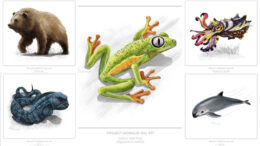You can accomplish a lot in a year.
Take artist Mesa Schumacher, for example. At the beginning of 2021 she set herself a lofty goal: Create and post illustrations for 365 species around the world.
With the final weeks of the year counting down, she’s accomplished what she set out to do and shared more than 300 digital illustrations of whales, reptiles, carnivores, birds, invertebrates and a host of other interesting creatures, many of which are threatened or endangered.
#Biodiversity is so important for our ecosystems to function. We barely scrape the surface in our knowledge of life and biostrategies that exist on our planet.
I challenge you to learn about a new #animal today (& tell me about it if you if you have time!)#sciart #biology pic.twitter.com/Bj2VxcCw1g
— Mesa Schumacher (@mesabree) October 26, 2021
Her Project Animalia helped fill a void in her life in the middle of the worldwide pandemic, when she found herself spending a lot more time at home with two young children.
“I was kind of in the depths of Covid winter despair,” Schumacher says. “I thought, ‘I just want to do something this year that’s going to be positive and that I can share.’ I committed to it the night before 2021.”
The work also helped fill a gap in her creative and professional life.
“I have a master’s in biomedical and medical illustration,” she says, “but I just love drawing animals, and frankly, there’s not as much demand drawing species anymore. We have so many photographs of animals.”
View this post on Instagram
It’s a bit ironic, then, that many of the images started with her own reference photos, collected during worldwide travels.
“I spent the last couple of years living in Katmandu,” she says. “I like visiting places where I can go searching for animals. I go out in the national parks and find some species that I wouldn’t have seen otherwise.”
That personal experience adds something special to her drawings, allowing her to capture a species’ personality, weight and the way it moves through the world.
“It’s always nice when I’ve had personal interaction with an animal, or I’ve gotten to see it in the wild,” she says. “Those drawings are kind special to me, and they often come out better.”
View this post on Instagram
Schumacher draws each animal digitally, starting on an iPad in a program called Procreate and finishing in Photoshop. Some images she completes in less than an hour. “Some of them take, uh, many hours,” she admits.
Although she started posting the results on Jan. 1, before she had a backlog of drawings ready to publish, she quickly adapted and has had as many as 10 or 20 in the works at a given time.
“I can work on them based on my mood,” she says. “Maybe I just feel like drawing scales.”
As the year progressed, Schumacher says she’s drawn many species from her own personal checklist. “There are a lot of species that I have wanted to draw for years and years, and I’ve just never gotten around to it.” That includes a fair number of whales:
Hey, it’s my birthday!
Happy day, here is Project Animalia day #16 Beluga whale (Delphinapterus leucas)Life is weird, and we’re a part of it. #sciart #animalart #wildlife #medart #dailyart #digitalart #scientificillustration #sciviz #Whale #whales #birding #naturelovers pic.twitter.com/lEcEW8E0pj
— Mesa Schumacher (@mesabree) January 16, 2021
Some of the animals, meanwhile, come from suggestions by her social-media followers, including scientists and conservationists around the world.
“That’s been the fun, connected part of this whole thing,” she says. “I don’t love social media, but I do love that this year it’s been connecting me to people who are passionate about something that I love. And the best thing about this has been these mini-collaborations with people making great requests of animals that I didn’t know about, or didn’t know that much about, and sharing their stories.”
In a similar vein, Schumacher found she helped open viewers’ eyes to some amazing, new-to-them species — which is how I learned about Madagascar’s satanic leaf-tailed gecko, which looks more like a fantasy illustration than a real animal:
Someone left the hell-mouth door open for the most metal of animals…disguised as a leaf and hanging from branches, it’s…
Day 253: Satanic leaf-tailed gecko (Setophaga petechia)
Project Animalia (Drawing a #sciart #illustration every day of 2021)#wildlifeart #animalart pic.twitter.com/qgWMRNg86d— Mesa Schumacher (@mesabree) September 10, 2021
“I love hearing it when people say, ‘Oh my God, I didn’t know this species existed and I just went down a rabbit hole and learned all these new things.’”
That, she says, may be the ultimate message of Project Animalia.
“Biodiversity and conservation have such implications for so many things, including pandemic diseases, but if people don’t even know if things exist, well, the better something is known the more people want to see it continue existing.”
With Day 365 looming, Schumacher says she’s grateful for the yearlong project, which has challenged her artistically. “I’ve become a better painter,” she says.
It’s also offered relief during troubling times. “It’s been a real spark. I think it kept me motivated while we’re all kind of in this dreary time.”
And with so many species under her belt, does Schumacher know yet what she’ll post on Dec. 31?
“That’s a secret,” she says, returning to her iPad.
Previously in The Revelator:
The Extinction Crisis in Watercolor and Oils: Using Art to Save Plants
![]()


